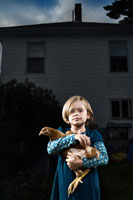
I have a photography mentor whose advice I often replay in my head. One of the sayings I most remember when I’m shooting my editorial portraits or more conceptual work is, “Leave them with questions rather than answers.”
This seems antithetical to my upbringing in newspaper photojournalism, where the success of a news photo hinges on the ability of the viewer to clearly digest what’s happening in the image with as little help from the caption as necessary.
But it only seems that way. The bread-and-butter of the community photojournalist isn’t spot news or hostage standoffs or even sports. Rather, it’s a big helping of portrait profiles with a side of found features (so-called “wild art”) and the occasional self-assignment photo essay or story. Every now and then, an illustration.
It’s in these non-news situations where my mentor’s advice rings true. A successful photo is one that isn’t totally literal. A great photo doesn’t tie up every loose end and dot every “i”. Whether because of an interesting expression, body language or other reasons, a photo that leaves something unresolved in the viewer’s mind is the one you’ll bet they’ll look at for a while before moving on to Dear Abby. They might even come back later to study the photo to try to figure it out themselves.
To boil it all down, I think that when you have an image that forces the viewer to fill in the blanks a bit—you may just have an image that can touch people. One master at this was the great portraitist Yousuf Karsh. He photographed many of the most iconic images of famous people in the 20th century, from Fidel Castro to Albert Einstein to Andy Warhol. You just have to view the iconic portrait of Sir Winston Churchill to see what Karsh was able to do (the backstory on this particular photo is fascinating and a worthwhile read). Looking at his images, the viewer is compelled to try and guess what the subjects are thinking at that moment. It’s as if you can see their souls and a little of their dirty laundry, too.
It’s an approach I always try to keep in mind when shooting images for certain clients, or for myself. Special thanks to Josephine, above, and her chicken, Maryanne.

